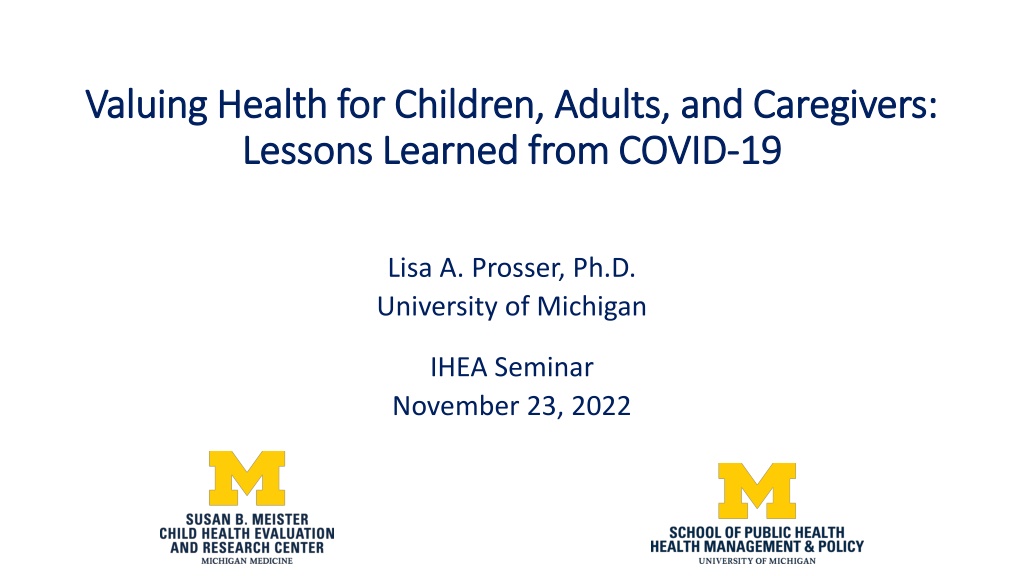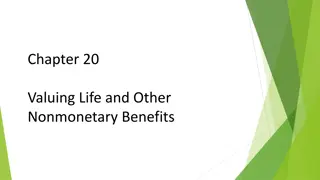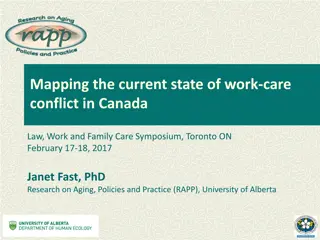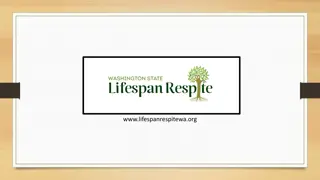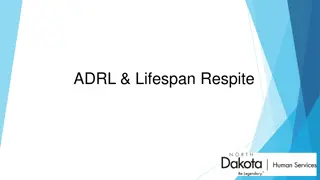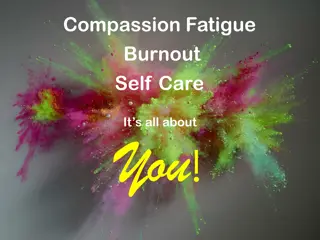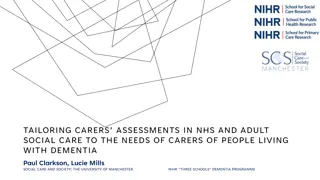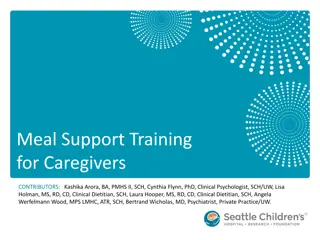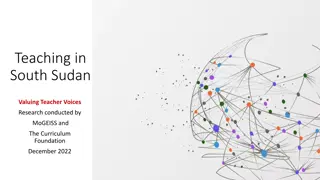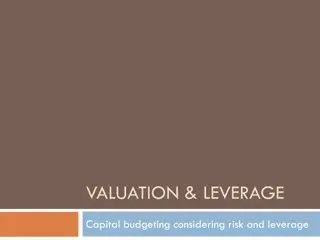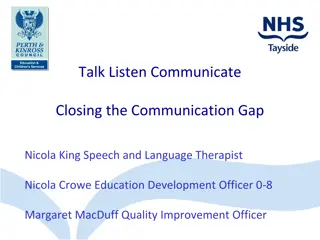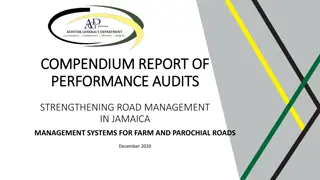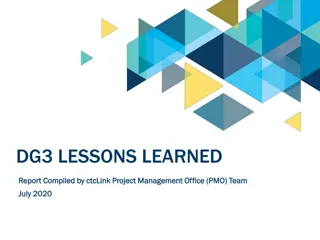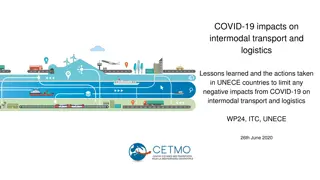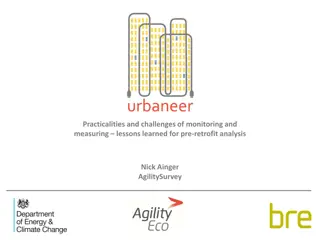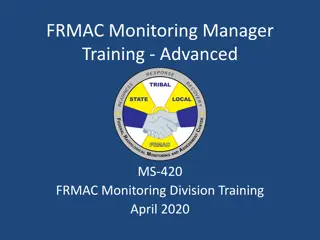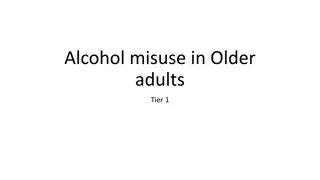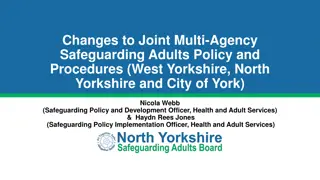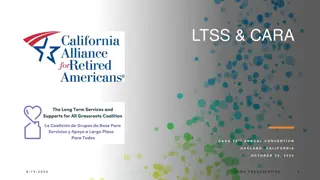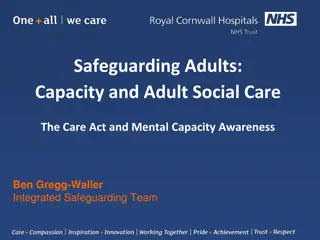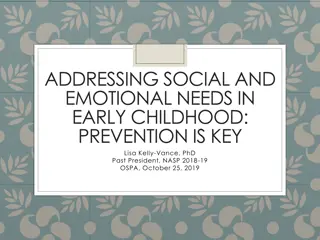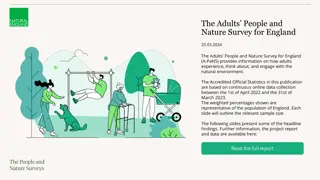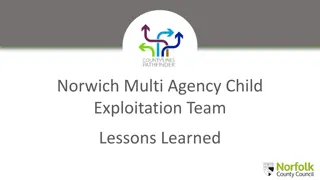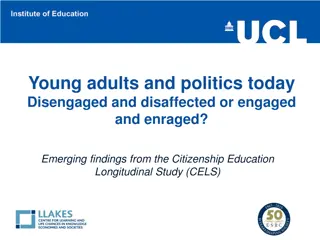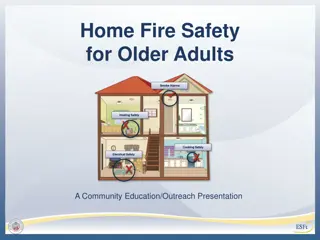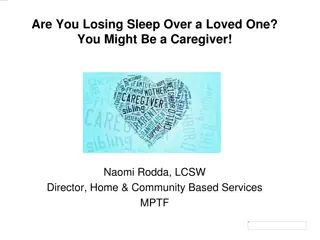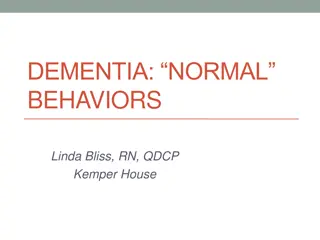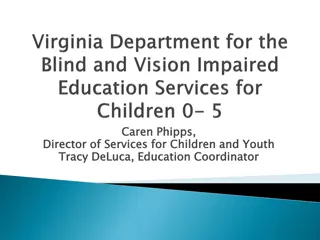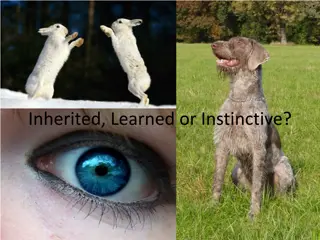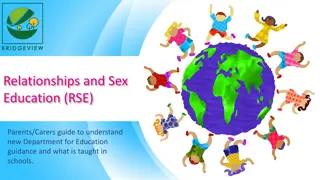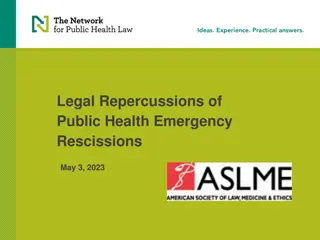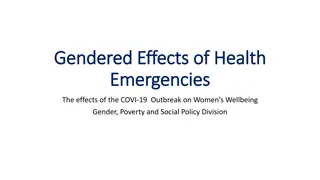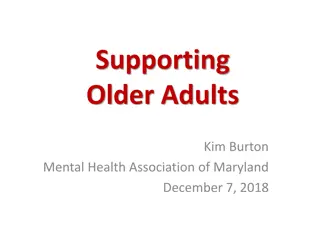Lessons Learned: Valuing Health for Children, Adults, and Caregivers
Exploring the impact of COVID-19 on health valuation for children, adults, and caregivers through economic evaluation, case examples, and eliciting utilities for child health. The study delves into family spillover effects, expanded value frameworks, and measuring QALY losses associated with COVID-19 illness, providing insights for healthcare decision-making.
Download Presentation

Please find below an Image/Link to download the presentation.
The content on the website is provided AS IS for your information and personal use only. It may not be sold, licensed, or shared on other websites without obtaining consent from the author. Download presentation by click this link. If you encounter any issues during the download, it is possible that the publisher has removed the file from their server.
E N D
Presentation Transcript
Valuing Health for Children, Adults, and Caregivers: Valuing Health for Children, Adults, and Caregivers: Lessons Learned from COVID Lessons Learned from COVID- -19 19 Lisa A. Prosser, Ph.D. University of Michigan IHEA Seminar November 23, 2022
Outline Overview of family spillover effects in the context of economic evaluation Case example: Measuring QALY losses associated with COVID-19 illness for children, adults, and family members Expanded value frameworks and family spillover effects 2
Early Example: Eliciting utilities for child health Early Example: Eliciting utilities for child health Measure values for preventing disease associated with pneumococcal infection 2002: Cost-effectiveness of pneumococcal conjugate vaccine (CDC collaborative study) Study sample: Parents of children with diagnosed pneumococcal disease (n=101) Community sample, national (n=109) Survey development challenges Elicitation Question - SG (Child Life for Child Health) Pretest 1: What chance of an immediate painless death would you accept to.. Prosser et al. Pediatrics, 2004 3
Early Example: Eliciting utilities for child health Early Example: Eliciting utilities for child health Measure values for preventing disease associated with pneumococcal infection 2002: Cost-effectiveness of pneumococcal conjugate vaccine (CDC collaborative study) Study sample: Parents of children with diagnosed pneumococcal disease (n=101) Community sample, national (n=109) Survey development challenges Elicitation Question - SG (Child Life for Child Health) Pretest 1: What chance of an immediate painless death would you accept to.. Prosser et al. Pediatrics, 2004 4
Early Example: Eliciting utilities for child health Early Example: Eliciting utilities for child health Measure values for preventing disease associated with pneumococcal infection 2002: Cost-effectiveness of pneumococcal conjugate vaccine (CDC collaborative study) Study sample: Parents of children with diagnosed pneumococcal disease (n=101) Community sample, national (n=109) Survey development challenges Elicitation Question - TTO (Child Life for Child Health) Pretest 1: How much time would you be willing to trade.. Prosser et al. Pediatrics, 2004 5
Early Example: Eliciting utilities for child health Early Example: Eliciting utilities for child health Measure values for preventing disease associated with pneumococcal infection 2002: Cost-effectiveness of pneumococcal conjugate vaccine (CDC collaborative study) Study sample: Parents of children with diagnosed pneumococcal disease (n=101) Community sample, national (n=109) Survey development challenges Elicitation Question - TTO (Child Life for Child Health) Pretest 1: How much time would you be willing to trade.. Prosser et al. Pediatrics, 2004 6
Early Example: Eliciting utilities for child health Early Example: Eliciting utilities for child health Elicitation Question - TTO (Parent Life for Combined Child/Parent Health State) New approach No standardized methods for valuing child health Pretest 1: How much time would you be willing to trade.. Prosser et al. Pediatrics, 2004 7
TTO amounts by age TTO amounts by age family spillover? family spillover? Value Health. 2011 8
Family Effects Family Effects A Definition A Definition Direct Costs Informal Care Family Effects HRQOL 9
Family Effects Family Effects Direct Costs Direct Costs Medical or non- medical, not covered by insurance Examples: Co-pays Transportation for a caregiver Home health aides (formal care) Home modifications to accommodate a wheelchair Direct Costs Informal Care Family Effects HRQoL Wittenberg & Prosser, 2016 10
Family Effects Family Effects Informal Care Informal Care Substantial burden especially at the ends of the lifespan, some examples: Caring for ventilator-dependent child in the home setting Accompanying children or older family members to medical appointments and treatments Caring for a spouse with dementia Direct Costs Informal Care Family Effects HRQoL 11 Wittenberg & Prosser, 2016; AARP, Caregiving in the US, 2020
Family Effects Family Effects HRQOL HRQOL Results from caring for or caring about Theoretical framework (Basu & Meltzer, JHE, 2005) Loss in HRQOL can be just as high for other family members as for primary caregiver (Bobinac et al., MDM, 2011) HRQOL impacts vary with relationship status to the ill individual, characteristics of the condition (disrupted relationship), and age of the patient (Prosser et al., MDM, 2015) Spillover is not all negative (Wittenberg et al., 2013) Direct Costs Informal Care Family Effects HRQoL 12
Domains affected by spillover, by respondent caregiver status (N=41) Domains affected by spillover, by respondent caregiver status (N=41) HRQOL v. QOL Little difference by caregiver status Wittenberg et al., Patient, 2013 13
Domains affected by spillover, by relationship of ill person to Domains affected by spillover, by relationship of ill person to respondent (N=49) respondent (N=49) Some differences by relationship to ill individual Wittenberg et al., Patient, 2013 14
Qualitative data Qualitative data HRQOL Impacts HRQOL Impacts Negative Positive The spouse of an individual with Alzheimer s disease reported: [I have] more determination to take care of myself. Mother of a child with depression said: It s a constant state of worry.. It s definitely emotionally difficult and physically difficult stomach upset, headaches, nervous, things like that And a spouse of someone with arthritis said: It s brought us closer together. Two mothers of children with cerebral palsy explained: We keep his bed in the living room so he can feel like he s part of the family He s a big part of our family. We wouldn t know what to do without him. I mean, he s got to have 24-hour care this is my life. The spouse of an Alzheimer s patient described sadness and depression: I m alone, I m alone in this I feel like I m in a sink- hole and it s just like my life is spiraling down. Wittenberg et al., Patient, 2013 15
Impact of Including Spillover in CEAs Impact of Including Spillover in CEAs Limited number studies have incorporated spillover into applied CEAs Results from systematic reviews: Of 142 pediatric CUAs, 72% included spillover (mostly time costs for informal caregiving); inclusion of spillover typically yielded more favorable results (Lavelle et al., AHEHP, 2019) Of 63 Alzheimer/dementia CUAs, 70% considered spillover (mostly informal caregiving time); inclusion yielded more favorable CEA ratios or remained cost saving (Lin et al., PEC, 2019) Of 40 CUAs that included family member QALYs, inclusion typically yielded more favorable ratios (Scope et al., Value in Health, 2022) Did not always represent substantial change 16
Data & Method Challenges: Family Data & Method Challenges: Family- -Level Costs & Informal Care Level Costs & Informal Care Lack of secondary data sources for direct costs to the family/standard approach to quantifying costs (micro costing) Lack of comprehensive data on informal caregiver time/alternative approaches to measurement & valuation 17
Data & Methods: HRQOL Spillover Data & Methods: HRQOL Spillover Systematic review of family spillover utilities (Wittenberg et al., PEC, 2019): Measured using both direct and indirect methods Lack of standardized approaches for valuation of spillover HRQOL effects Equity questions of investing in caregiver burden or patient health (Al- Janabi et al., Soc Sci Med, 2021) Caregiver ~0.70 Family member ~0.80 How to define family? Where to draw the circle (Canaway et al., PEC, 2019) 18
How wide to draw the circle? How wide to draw the circle? Other family members, siblings, grandparents, other household members Ill Child Extended family? Teachers? Other students? Parents 19 Adapted from Canaway et al., PharmacoEconomics, 2019
QALY Losses Due to COVID QALY Losses Due to COVID- -29 Illness 29 Illness Objective: To measure the value of lost health-related quality of life due to COVID-19 illness for patients and caregivers via health utility assessment [originally designed for RSV, expanded to include COVID-19] 20
Disclosure Disclosure I have no actual or potential conflict of interest in relation to this presentation. The findings and conclusions in this report are those of the authors and do not necessarily represent the official position of the Centers for Disease Control and Prevention. Funding Acknowledgment: Centers for Disease Control and Prevention, Joint Initiative in Vaccine Economics, Phase 6 U01IP001104 21 21
Research Team Research Team University of Michigan Lisa A. Prosser, PhD David Hutton, PhD Cara Janusz, PhD Acham Gebremariam, MS Angela Rose, MPH Kerra Mercon, MS CDC Jamie Pike, PhD Marie Killerby, VetMB, MPH Christopher Taylor, PhD Meredith McMorrow, MD, MPH Jefferson Jones, MD, MPH Harvard University Eve Wittenberg, PhD 22
Methods Methods Online survey to elicit time trade-off amounts for COVID-19 illness and family spillover 8 COVID health states 4 spillover health states (child only) 23
Survey Design Survey Design Time trade-off (TTO) questions Modified bisection approach to elicit TTO amounts Double-bounded dichotomous choice questions Initial bid followed up by second bid Followed by open-ended question 4 bid vectors, respondents randomized Based on similar approaches for willingness-to-pay/contingent valuation No gold standard for temporary health states (Wright et al., 2009) Alternative: limit time available to trade to length of health state/ does not allow for states worse than dead 24
Bid Vectors Health State Bid Group 1 Group 2 Group 3 Group 4 Initial Bid 2 days 4 days 1 week 2 weeks Outpatient High Bid 4 days 1 week 2 weeks 1 month Low Bid 1 day 2 days 4 days 1 week Initial Bid 2 weeks 1 month 2 months 8 months Hospitalized (all) High Bid 1 month 2 months 4 months 1 year Low Bid 1 week 2 weeks 1 month 4 months Initial Bid 1 month 3 months 6 months 2 years Long COVID High Bid 2 months 6 months 1 year 4 years Low Bid 2 weeks 1 month 3 months 1 year 25
Survey Instrument Survey Instrument Introduction and practice TTO question (influenza) 6 TTO questions 2 health states Self, child, spillover (family member of ill child) Demographic questions COVID-19 beliefs/attitudes Vaccination status (including intent to vaccinate) Experience with COVID illness Level of concern about COVID 26
Intentional Design Changes Intentional Design Changes Labeled health states Uncertainty Effects beyond ill individual transmission Effects beyond HRQOL - isolation 27
Outpatient COVID Outpatient COVID- -19 19 [ADULT] Imagine that you have an illness: You have a moderate cough and a low-grade fever for the first few days, but are generally able to complete your usual activities despite feeling tired You are tested for COVID-19 and find out that you are positive You don t know when you will get better and there is a chance that your illness will worsen and you will need to be hospitalized Over the next several days you feel extremely tired, your cough worsens, you have a consistently high fever, and severe chills. You are unable to complete normal household activities at home and are unable to go to work For the entire time, you are contagious to other people and must remain isolated in your room without any contact with your family or friends and you cannot go to work in-person After about 2 weeks, you are feeling better your cough and fever are gone but you re still a bit tired. You slowly return to your usual energy level over the next couple of weeks [CHILD] Imagine that your child has an illness: Your child is tested for COVID-19 and you find out that he or she is positive You don t know when your child will get better and there is a chance that your child s illness will worsen and your child will need to be hospitalized For the first few days, your child has difficulty doing normal activities due to his or her illness For the next week, your child continue to have a runny nose and sore throat, but is able to complete his or her usual activities at home For the entire time, your child is contagious to other people and must remain isolated in his or her room without any contact with family members and is unable to go to school or daycare Your child completely recovers and has no more problems related to having the illness 28
Hospitalized with COVID Hospitalized with COVID- -19 19 [ADULT] Imagine you have an illness: You feel very tired and have a fever You struggle to take a deep breath and have a bad cough, and chest pain You are tested for COVID-19 and find out that you are positive. After about a week you are feeling worse and you go to the emergency room. At the hospital you have an X-ray and are given an IV for medications and oxygen to help you breathe more easily. You are admitted to the hospital and stay there for 5-10 days recovering and being treated. You don t know whether your treatment will work and there is a chance that your illness could worsen and that you would require ICU (Intensive Care Unit) care and a ventilator to help you breathe. You are alone during most of your hospital stay. Your family cannot visit you in the hospital because you could infect them with COVID-19 and all hospital staff must wear full protective clothing, masks and shields when they come into your room to check on you. After returning home, it takes several weeks for you to return to normal activities and work. [CHILD] Imagine that your child has an illness: Your child has a fever and cough and is very tired. Your child has a runny nose or is congested and has a sore throat. Your child is tested for COVID-19 and you find out that he or she is positive. After about a week of not getting any better, your child starts to have problems breathing and you go to the emergency room. At the hospital your child has an X-ray and is given an IV for medications. Your child stays there for 5-10 days recovering and being treated. You don t know whether your treatment will work and there is a chance that your child s illness could worsen and that he or she would require ICU (Intensive Care Unit) care and a ventilator to help them breathe. Only one parent can stay with your child and you cannot have other visitors because your child is very contagious. All hospital staff must wear full protective clothing, masks and shields when they come into your child s room. After hospitalization, it takes a week or so for your child to return to normal activities and daycare or school. Your child completely recovers and has no more problems related to having the illness. 29
Hospitalized/ICU & Hospitalized/MIS Hospitalized/ICU & Hospitalized/MIS- -C C [ADULT] Imagine that you have an illness: You feel very tired and have a high fever You have a lot of trouble breathing and a severe cough You are tested for COVID-19 and find out that you are positive. After a couple of days of getting worse, you notice that you are so short of breath that you have trouble walking and you go to the emergency room. At the hospital you have an X-ray, are treated with several medications, and get oxygen to help you breathe more easily. You don t know whether your treatment will work and there is a chance that your illness could worsen and that you would require ICU (Intensive Care Unit) care. You continue to get worse and on your second day you are admitted to the ICU and are put on a ventilator to breathe for you. You stay there for 14 days hooked up to the ventilator, lying face down, with tubes in your stomach and bladder. Your family is told that you might not survive this illness. You are alone during most of your hospital stay. Your family cannot visit you because you are contagious. All hospital staff must wear full protective clothing, masks and shields when they come into your room to check on you. After returning home, it takes several weeks for you to return to normal activities and work. 30
Chronic COVID Chronic COVID- -19 (long COVID) 19 (long COVID) [ADULT] Imagine that you have an illness: After your COVID-19 illness, you continue to be very tired and have a stuffy nose, cough, and sore throat Your cold-like symptoms eventually improve but you remain extremely tired which makes it very difficult to work and do your normal activities You easily become out of breath when you walk and often get dizzy when you stand up. Your joints also hurt and your brain feels foggy. Your symptoms come and go. They seem to improve for a while but then worsen again and you don t know when you ll fully recover. After 6 months, most people feel better, but some people continue to have symptoms for a longer period of time. [CHILD] Imagine that your child has an illness: After your child s COVID-19 illness, he or she continues to be very tired Your child has nausea and diarrhea and has lost his or her appetite Your child also has a rash and frequently gets headaches or other body aches. Because of your child s symptoms, he or she spends a lot of time resting and is sometimes unable to attend school or daycare. Your child s symptoms come and go. They seem to improve for a few days, but then worsen again and you don t know when your child will get better. After 6 months, most children feel better, but some children continue to have symptoms for a longer period of time. 31
Outpatient COVID-19 Example Question Example Question (Self) (Self) Imagine that you have an illness: You have a moderate cough and a low-grade fever for the first few days, but are generally able to complete your usual activities despite feeling tired. You are tested for COVID-19 and find out that you are positive. You don t know when you will get better and there is a chance that your illness will worsen and you will need to be hospitalized. Over the next several days you feel extremely tired, your cough worsens, you have a consistently high fever, and severe chills. You are unable to complete normal household activities at home and are unable to go to work. For the entire time, you are contagious to other people and must remain isolated in your room without any contact with your family or friends and you cannot go to work in-person. After about 2 weeks, you are feeling better your cough and fever are gone but you re still a bit tired. You slowly return to your usual energy level over the next couple of weeks. Imagine that you have 41 years left to live. What portion of your life, if any, would you have been willing to give up from the end of YOUR life to avoid this experience with the illness? You can choose any amount of time in days, weeks, or months. Would you be willing to give up 2 weeks in order to avoid this scenario? Yes No
Outpatient COVID-19 Example Question Example Question (Child) (Child) Imagine that your child has an illness: Your child has a moderate cough and a low-grade fever for the first few days, but is generally able to complete his or her usual activities despite feeling tired. Your child is tested for COVID-19 and finds out that he or she is positive. You don t know when your child will get better and there is a chance that your child s illness will worsen and your child will need to be hospitalized. Over the next several days your child feels extremely tired, his or her cough worsens and he or she has a consistently high fever and severe chills. Your child is unable to complete his or her normal activities at home and is unable to go to school. For the entire time, your child is contagious to other people and must remain isolated in his or her room without any contact with family or friends and cannot go to work in-person. After about 2 weeks, your child is feeling better his or her cough and fever are gone but they are still a bit tired. Your child slowly returns to their usual energy level over the next couple of weeks. Imagine that you have 41 years left to live. What portion of your life, if any, would you have been willing to give up from the end of YOUR life to avoid your child s experience with the illness? You can choose any amount of time in days, weeks, or months. Would you be willing to give up 2 weeks in order to avoid this scenario? Yes No
Example Question Example Question (Child Spillover) (Child Spillover)
Survey Administration Survey Administration Nationally representative online panel - AmeriSpeak NORC at the University of Chicago Probability-based panel representative of the US household population Randomly-selected US households are sampled using area probability and address-based sampling Provides sample coverage of ~97% of the U.S. household population Survey responses collected: April 16, 2021- May 7, 2021 Completion rate: 30.3% n = 1014 (randomized to one of 3 versions) 35
Respondent Characteristics (n=1014) Respondent Characteristics (n=1014) No. % % No. Self-reported health status Excellent Very Good Good Fair Poor Family experience with COVID-19 COVID-19 Hospitalized with COVID-19 No experience COVID-19 vaccine plans* Received Intend Delay No COVID-19 not as problematic as media presents* Strongly Agree Agree Disagree Strongly Disagree Gender Male Female Age Mean age, years (min-max) Race White Black Mixed/Other Hispanic Asian Education < High School/High School / GED Some College/Bachelor s Degree Advanced Degree Household income Under $29,999 $30,000 to $74,999 $75,000 or more Children (0-17 y) in household Respondents thinking of a child of specific age Mean Age of Child, years (min-max) 110 398 356 126 24 10.8 39.3 35.1 12.4 2.4 49.4 50.6 501 513 - 48 (18-89) 63.9 10.3 4.9 17.5 3.5 648 104 50 177 35 298 59 716 29.4 5.8 70.6 635 82 142 151 62.9 8.1 14.1 15.0 23.9 60.2 15.8 243 611 160 130 200 295 385 12.9 19.8 29.2 38.1 22.9 41.2 36 19.0 232 417 365 193 *Not all respondents answered this question (n=1010) - 9 (0-62)
Analysis Plan Exclude respondents with low confidence in responses & illogical responses (same TTO for all health states/protest answers, outliers) Primary analysis: Maximum TTO amounts QALY losses (max TTO / life expectancy) Disutility (QALYdayslost / days in health state) Utility proxy (1 - disutility loss) Bootstrapped 95% CI for means Secondary analyses Regression analyses 37
Analysis Plan- Exclusion Rules Number of respondents Type Description Indicated yes to the question: I did not understand what was being asked Didn t understand task 3 Remove respondents who entered comments indicating that they refused to trade off time for this exercise Protest comments 7 Total respondents excluded 10 38
Secondary & Regression Analyses Secondary Analyses: Exclude incompletes Exclude respondents who answered <1/2 of valuation questions Set upper bound for TTO for responses that trade off more time than have left, set Max TTO = life expectancy Restrict to AYAs for child frame Exclude respondents if they provided age of the child they were thinking of >25 years Invariant scores across health states- Exclude respondents with same non-zero max time trade off across the 6 time trade off questions equal to life expectancy (for those who answered >50% of the health states) Stratified analysis for those less/more concerned about COVID- Dichotomize Covid concern variable into: Denier (strongly agree/agree) or Acceptor (strongly disagree/disagree) Stratified analysis for Covid vaccination status/intentions- Dichotomize Covid vaccination status into Yes (Received/intend) vs No (delay/no) Regression Analyses Model 1 adjusted for age, gender, race/ethnicity, education, marital status, household income, geographic region Model 2 adjusted for family experience with COVID, COVID vaccination plans, COVID denier 39
Maximum TTO Amounts (Days) COVID Maximum TTO Amounts (Days) COVID- -19 19 COVID Health State Mean Median p5- p95 197.3 702.9 264.8 452.5 1086.3 664.3 424.4 1207.2 950.6 537.8 1206.8 766.2 7.0 10.0 4.0 30.4 60.9 14.0 30.4 121.8 30.4 91.3 182.6 60.9 0.0 - 365.3 0.0 - 3652.5 0.0 - 730.5 0.0 - 1095.8 0.0 - 7305 0.0 - 1826.3 0.0 - 1826.3 0.0 - 7305 0.0 - 5844 0.0 - 1826.3 0.0 - 7305 0.0 - 3652.5 Outpatient Adult Child Child Spillover Adult Child Child Spillover Adult Child Child Spillover Adult Child Child Spillover Hospitalized Hospitalized - ICU Hospitalized - MIS-C Long COVID DO NOT CITE OR QUOTE
Time trade off amounts A. Outpatient B. Hospitalized 1400 1400 1200 1200 1086 1000 1000 703 800 800 664 600 600 453 400 265 400 197 200 200 0 0 Adult Child Child Spillover Adult Child Child Spillover C. Hospitalized- ICU or MIS-C D. Long COVID 1400 1400 1207 1207 1200 1200 951 1000 1000 766 800 800 538 600 600 424 400 400 200 200 0 0 Adult Child Child Spillover Adult Child Child Spillover
QALY Losses QALY Losses Mean (QALY Loss) 0.019 95% CI (bootstrap) Median p5-p95 Covid Health State Outpatient Adult 0.008 - 0.033 0.001 0 - 0.046 Child 0.07 0.041 - 0.106 0.001 0 - 0.667 Child Spillover 0.036 0.015 - 0.065 0 0 - 0.071 Hospitalized Adult 0.045 0.025 - 0.070 0.003 0 - 0.115 Child 0.092 0.064 - 0.126 0.005 0 - 1 Child Spillover 0.06 0.037 - 0.085 0.001 0 - 0.294 Hospitalized - ICU Adult 0.046 0.027 - 0.068 0.004 0 - 0.167 Hospitalized - MIS- C Child Child Spillover 0.102 0.081 0.073 - 0.135 0.052 - 0.116 0.011 0.003 0 - 0.885 0 - 0.547 Long COVID Adult 0.056 0.035 - 0.084 0.008 0 - 0.182 Child Child Spillover DO NOT CITE OR QUOTE 0.11 0.082 - 0.143 0.019 0 - 0.857 0.074 0.051 - 0.105 0.006 0 - 0.313
QALYs lost A. Outpatient B. Hospitalized 1.0 1.0 0.8 0.8 0.6 0.6 0.4 0.4 0.2 0.2 0.092 0.07 0.06 0.045 0.036 0.019 0.0 0.0 Adult Child Child Spillover Adult Child Child Spillover C. Hospitalized- ICU or MIS-C D. Long COVID 1.0 1.0 0.8 0.8 0.6 0.6 0.4 0.4 0.2 0.102 0.2 0.11 0.081 0.074 0.046 0.056 0.0 0.0 Adult Child Child Spillover Adult Child Child Spillover
Quality Quality- -Adjusted Life DAYS Lost Adjusted Life DAYS Lost Mean (Days) 6.8 25.7 13.2 16.4 33.7 21.8 16.6 37.1 29.6 20.5 40.1 27 95% CI (bootstrap) 2.7 - 11.9 14.9 - 38.2 5.2 - 24.0 9.2 - 25.6 23.3 - 46.0 13.8 - 31.3 9.9 - 24.6 26.7 - 49.1 18.9 - 42.1 12.8 - 30.5 29.7 - 52.2 18.2 - 37.8 Median 0.2 0.3 0.1 1 1.9 0.5 1.4 3.9 1.2 2.9 7 2.2 p5-p95 0 - 16.6 0 - 243.5 0 - 26.1 0 - 42.1 0 - 365.3 0 - 107.4 0 - 60.9 0 - 323.1 0 - 199.9 0 - 66.4 0 - 313.1 0 - 114.1 COVID-19 Health State Outpatient Adult Child Child Spillover Adult Child Child Spillover Adult Child Child Spillover Adult Child Child Spillover Hospitalized Hospitalized - ICU Hospitalized - MIS-C Long COVID DO NOT CITE OR QUOTE
Quality-adjusted days lost A. Outpatient B. Hospitalized 50 50 40 40 33.7 30 30 25.7 21.8 16.4 20 20 13.2 6.8 10 10 0 0 Adult Child Child Spillover Adult Child Child Spillover C. Hospitalized- ICU or MIS-C D. Long COVID 50 50 40.1 37.1 40 40 29.6 30 27.0 30 20.5 16.6 20 20 10 10 0 0 Adult Child Child Spillover Adult Child Child Spillover
Comparing QALY Losses for COVID Comparing QALY Losses for COVID- -19 and Influenza Health States States 19 and Influenza Health COVID-19 Influenza RSV Mean Range Mean Range Mean Range Outpatient 0.010 0.009 - 0.011 0.019 0.005 - 0.035 Adult 0.019 0.008 - 0.033 0.028 0.026 - 0.031 0.045 0.021 - 0.075 Child 0.07 0.041 - 0.106 Hospitalized 0.018 0.016 - 0.020 0.019 0.010 - 0.032 Adult 0.045 0.025 - 0.070 0.029 0.027 - 0.032 0.073 0.044 - 0.106 Child 0.092 0.064 - 0.126 46
Comparing QALY losses for those less vs more concerned about COVID-19 Less concerned about COVID-19 (32%) Mean Median More concerned about COVID-19 (68%) Mean Median Variable Adult p5 p95 p5 p95 Outpatient 0.004 0.000 0.-0.0083 0.026 0.001 0.-0.053 Child 0.014 0.001 0.-0.0263 0.096 0.001 0.-1 Child Spillover 0.013 0.000 0.-0.01 0.047 0.000 0.-0.098 Hospitalized Adult 0.005 0.001 0.-0.0238 0.064 0.005 0.-0.192 Child 0.064 0.001 0.-0.2 0.106 0.008 0.-1 Child Spillover 0.016 0.000 0.-0.0385 0.081 0.002 0.-0.962 Hospitalized- ICU Adult 0.026 0.002 0.-0.0526 0.054 0.005 0.-0.192 Hospitalized- MIS-C Child 0.125 0.004 0.-1 0.092 0.017 0.-0.571 Child Spillover 0.107 0.001 0.-1 0.070 0.005 0.-0.547 Long COVID Adult 0.058 0.001 0.-0.116 0.055 0.011 0.-0.216 Child 0.117 0.004 0.-1 0.107 0.024 0.-0.714 Child Spillover 0.061 0.001 0.-0.227 0.080 0.011 0.-0.370 DO NOT CITE OR QUOTE
QALYs lost: comparing those more and less concerned about COVID A. Outpatient B. Hospitalized More concerned about Covid Less concerned about Covid More concerned about Covid Less concerned about Covid 1 1 1 1 0.8 0.8 0.8 0.8 0.6 0.6 0.6 0.6 0.4 0.4 0.4 0.4 0.2 0.2 0.106 0.2 0.2 0.081 0.096 0.064 0.064 0.047 0.016 0.005 0.026 0.014 0.013 0.004 0 0 0 0 Adult Child Child Spillover Adult Child Child Spillover Adult Child Child Spillover Adult Child Child Spillover D. Long COVID C. Hospitalized- ICU/MIS-C 1 1 1 1 0.8 0.8 0.8 0.8 0.6 0.6 0.6 0.6 0.4 0.4 0.4 0.4 0.2 0.125 0.2 0.2 0.2 0.117 0.107 0.107 0.092 0.07 0.08 0.054 0.061 0.058 0.055 0.026 0 0 0 0 Adult Child Child Spillover Adult Child Child Spillover Adult Child Child Spillover Adult Child Child Spillover
Comparing QALY losses by vaccination status Intend to receive vaccine Median Do not intend to receive vaccine Mean Median Variable Adult Mean p5 p95 p5 p95 Outpatient 0.022 0.001 0.-0.053 0.004 0.000 0.-0.009 Child 0.072 0.001 0.-1 0.064 0.001 0.-0.133 Child Spillover 0.041 0.000 0.-0.088 0.020 0.000 0.-0.044 Hospitalized Adult 0.047 0.004 0.-0.147 0.041 0.001 0.-0.115 Child 0.086 0.007 0.-0.313 0.110 0.002 0.-1 Child Spillover 0.058 0.002 0.-0.231 0.064 0.000 0.-1 Hospitalized- ICU Adult 0.052 0.006 0.-0.167 0.032 0.001 0.-0.065 Hospitalized- MIS-C Child 0.103 0.015 0.-0.571 0.099 0.004 0.-1 Child Spillover 0.077 0.004 0.-0.351 0.092 0.002 0.-1 Long COVID Adult 0.058 0.010 0.-0.171 0.053 0.001 0.-0.269 Child 0.109 0.023 0.-0.556 0.113 0.010 0.-1 Child Spillover 0.075 0.011 0.-0.313 0.072 0.001 0.-0.885 DO NOT CITE OR QUOTE
QALYs lost: Intend vs do not intend to vaccinate A. Outpatient B. Hospitalized Intend to vaccinate Do not intend to vaccinate Intend to vaccinate Do not intend to vaccinate 1 1 1 1 0.8 0.8 0.8 0.8 0.6 0.6 0.6 0.6 0.4 0.4 0.4 0.4 0.2 0.2 0.11 0.086 0.2 0.2 0.064 0.058 0.047 0.072 0.041 0.064 0.041 0.022 0.02 0.004 0 0 0 0 Adult Child Child Spillover Adult Child Child Spillover Adult Child Child Spillover Adult Child Child Spillover C. Hospitalized- ICU or MIS-C D. Long COVID 1 1 1 1 0.8 0.8 0.8 0.8 0.6 0.6 0.6 0.6 0.4 0.4 0.4 0.4 0.2 0.2 0.2 0.113 0.103 0.2 0.099 0.109 0.092 0.077 0.072 0.075 0.052 0.053 0.058 0.032 0 0 0 0 Adult Child Child Spillover Adult Child Child Spillover Adult Child Child Spillover Adult Child Child Spillover
